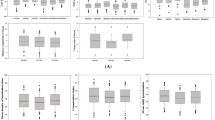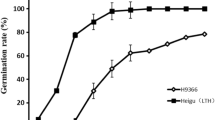Abstract
Rice growth and productivity are greatly affected by cold stress, which is likely to become more of a hindrance for high and stable rice yields. To identify cold tolerance at the booting and flowering stages in rice, a recombinant inbred line was developed by crossing a cold-tolerant japonica cultivated variety, Jileng1, with a cold-sensitive indica cultivated variety, Milyang23. The seed setting rate (SST) of the parents and RIL population were investigated under different temperature environments, and the SST and cold stress tolerance index under natural low temperature were used to evaluate cold tolerance and quantitative trait locus (QTL) mapping. Fifteen QTLs were detected on chromosomes 1, 2, 3, 5, 7, 11 and 12, with log-likelihood values ranging from 2.64 to 4.76. These QTLs account for 3.34% to 12.02% of the phenotypic variance explained. Three QTLs, qCtb1, qCtb5 and qCtb12, were repeatedly detected in different conditions, and they were considered stably expressed QTLs. qCtb5 was localized to chromosome 5 marker between CMB0526.3 and ID5014265. In this interval or nearby, many cold-resistance QTLs have been identified in previous studies, so qCtb5 is considered a major cold-tolerance QTL. Thirteen QTLs with environmental interactions were also detected, and QTLs detected in single environment were all found to be involved in environmental interactions. These results show that environmental interactions have a significant effect on cold tolerance in rice. Stable expression of major QTLs will help to fine mapping cold-tolerance genes and provide gene resources to cultivate cold-tolerance rice varieties.




Similar content being viewed by others
Data availability
All data included in this study are available upon request by contact with the corresponding author.
References
Andaya VC, Mackill DJ (2003a) Mapping of QTLs associated with cold tolerance during the vegetative stage in rice. J Exp Bot 54(392):2579–2585. https://doi.org/10.1093/jxb/erg243
Andaya VC, Mackill DJ (2003b) QTLs conferring cold tolerance at the booting stage of rice using recombinant inbred lines from a japonica x indica cross. Theor Appl Genet 106(6):1084–1090. https://doi.org/10.1007/s00122-002-1126-7
Cruz RPd, Sperotto RA, Cargnelutti D, Adamski JM, FreitasTerra TD, Fett JP (2013) Avoiding damage and achieving cold tolerance in rice plants. Food Energy Secur 2(2):96–119. https://doi.org/10.1002/fes3.25
Endo T, Chiba B, Wagatsuma K, Saeki K, Ando T, Shomura A, Mizubayashi T, Ueda T, Yamamoto T, Nishio T (2016) Detection of QTLs for cold tolerance of rice cultivar ‘Kuchum’ and effect of QTL pyramiding. Theor Appl Genet 129(3):631–640. https://doi.org/10.1007/S00122-015-2654-2
Fujino K, Obara M, Shimizu T, Koyanagi KO, Ikegaya T (2015) Genome-wide association mapping focusing on a rice population derived from rice breeding programs in a region. Breed Sci 65(5):403–410. https://doi.org/10.1270/jsbbs.65.403
Guo HF, Zeng YW, Li JL, Ma XQ, Zhang ZY, Qj L, Li J, Gu YS, Zhang HL, Li JJ, Li ZC (2020) Differentiation, evolution and utilization of natural alleles for cold adaptability at the reproductive stage in rice. Plant Biotechnol J 18(12):2491–2503. https://doi.org/10.1111/PBI.13424
Han LZ, Zhang SY, Qiao YL, Ruan RC, Zhang JG, Cao GL, Koh HJ (2005a) QTL analysis of root traits at the seedling stage in rice under cold water irrigation. Acta Agron Sin 31(11):1415–1421 (in Chinese)
Han LZ, Qiao YL, Zhang YY, Cao GL, Yea JD, Koh HJ (2005b) Identification of QTLs for cold tolerance at the booting stage in rice. Acta Agron Sin 31(5):653–657 (in Chinese)
Han LZ, Qiao YL, Zhang SY, Cao GL, Ye CR, Xu FR, Dai LY, Ye JD, Koh HJ (2005c) QTL analysis of some agronomic traits in rice under different growing environments. Scientia Agricultura Sinica 38(6):1080–1087 (in Chinese)
Jiang S, Yang C, Xu Q, Wang L, Yang X, Song X, Wang J, Zhang X, Li B, Li H, Li Z, Li W (2020) Genetic dissection of germinability under low temperature by building a resequencing linkage map in japonica rice. Int J Mol Sci 21(4):1284. https://doi.org/10.3390/ijms21041284
Jiang WZ, Lee JH, Chu SH, Ham TH, Woo MO, Cho YI, Chin JY, Han LZ, Xuan YS, Yuan DL, Xu FR, Dai LY, Yea JD, Koh HJ (2010) Genotype×environment interactions for chilling tolerance of rice recombinant inbred lines under different low temperature environments. Field Crops Res 117(2):226–236. https://doi.org/10.1016/J.FCR.2010.03.007
Jiang WZ, Jin YM, Lee JH, Lee KL, Piao RH, Han LZ, Shin JC, Jin RD, Cao TH, Pan HY, Du XL, Koh HJ (2011) Quantitative trait loci for cold tolerance of rice recombinant inbred lines in low temperature environments. Mol Cells 32(6):579–587. https://doi.org/10.1007/S10059-011-0186-4
Kuroki M, Saito K, Matsuba S, Yokogami N, Shimizu H, Ando I, Sato Y (2007) A quantitative trait locus for cold tolerance at the booting stage on rice chromosome 8. Theor Appl Genet 115(5):593–600. https://doi.org/10.1007/S00122-007-0589-Y
Li HH, Ye GY, Wang JK (2007) A modified algorithm for the improvement of composite interval mapping. Genetics 175:361–374. https://doi.org/10.1534/genetics.106.066811
Li J, Pan Y, Guo H, Zhou L, Yang S, Zhang Z, Yang J, Zhang H, Li J, Zeng Y, Li Z (2017) Fine mapping of QTL qCTB10-2 that confers cold tolerance at the booting stage in rice. Theor Appl Genet 131(1):157–166. https://doi.org/10.1007/s00122-017-2992-3
Li L, Liu X, Xie K, Wang Y, Liu F, Lin Q, Wang W, Yang C, Lu B, Liu S, Chen L, Jiang L, Wan J (2013) qLTG-9, a stable quantitative trait locus for low-temperature germination in rice (Oryza sativa L.). Theor Appl Genet 126(9):2313–2322. https://doi.org/10.1007/s00122-013-2137-2
Li SS, Wang JK, Zhang LY (2015) Inclusive composite interval mapping of QTL by environment interactions in biparental populations. PLoS ONE 10(7):e0132414. https://doi.org/10.1371/journal.pone.0132414
Liu FX, Xu WY, Song Q, Tan LB, Liu JY, Zhu ZF, Fu YC, Su Z, Sun CQ (2013) Microarray-assisted fine-mapping of quantitative trait loci for cold tolerance in rice. Mol Plant 6(3):757–767. https://doi.org/10.1093/MP/SSS161
Meng L, Li HH, Zhang LY, Wang JK (2015) QTL IciMapping: Integrated software for genetic linkage map construction and quantitative trait locus mapping in biparental populations. Crop J 3:269–283. https://doi.org/10.1016/j.cj.2015.01.001
McCouch SR, Cho YG, Yano M, Paul E, Blinstrub M, Morishima H, Kinoshita T (1997) Report on QTL nomenclature. Rice Genet Newsl 14:11–13
Najeeb S, Ali J, Mahender A, Pang YL, Zilhas J, Murugaiyan V, Vemireddy LR, Li Z (2020) Identification of main-effect quantitative trait loci (QTLs) for low-temperature stress tolerance germination- and early seedling vigor-related traits in rice (Oryza sativa L.). Mol Breed 40(1):10. https://doi.org/10.1007/S11032-019-1090-4
Saito K, Miura K, Nagano K, Hayano-Saito Y, Araki H, Kato A (2001) Identification of two closely linked quantitative trait loci for cold tolerance on chromosome 4 of rice and their association with anther length. Theor Appl Genet 103:862–868. https://doi.org/10.1007/s001220100661
Saito K, Hayano-Saito Y, Maruyama-Funatsuki W, Sato Y, Kato A (2004) Physical mapping and putative candidate gene identification of a quantitative trait locus Ctb1 for cold tolerance at the booting stage of rice. Theor Appl Genet 109(3):515–522. https://doi.org/10.1007/s00122-004-1667-z
Saito K, Hayano-Saito Y, Kuroki M, Sato Y (2010) Map-based cloning of the rice cold tolerance gene Ctb1. Plant Sci 179(1–2):97–102. https://doi.org/10.1016/j.plantsci.2010.04.004
Sasaki T, Burr B (2000) International rice genome sequencing project: the effort to completely sequence the rice genome. Curr Opin Plant Biol 3:138–141. https://doi.org/10.1016/S1369-5266(99)00047-3
Sun J, Yang L, Wang J, Liu H, Zheng H, Xie D, Zhang M, Feng M, Jia Y, Zhao H, Zou D (2018) Identification of a cold-tolerant locus in rice (Oryza sativa L.) using bulked segregant analysis with a next-generation sequencing strategy. Rice (N Y) 11(1):24. https://doi.org/10.1186/s12284-018-0218-1
Ooijen JV, Ooijen JV, Verlaat JV, Ooijen J, Tol JV, Dalen J, Buren J, Meer JVD, Krieken JV, Ooijen J, Kessel JV, Van O, Voorrips R, Heuvel LVD (2006) JoinMap® 4, Software for the calculation of genetic linkage maps in experimental populations. Kyazma B.V., Wageningen, Netherlands
Tang JH, Ma XD, Cui D, Han B, Geng LY, Zhao ZW, Li YF, Han LZ (2019) QTL analysis of main agronomic traits in rice under low temperature stress. Euphytica. https://doi.org/10.1007/s10681-019-2507-1
Voorrips RE (2002) MapChart: software for the graphical presentation of linkage maps and qtls. J Hered 93(1):77–78
Xie LX, Tan ZW, Zhou YY, Xu RB, Feng LB, Xing YZ, Qi XQ (2014) Identification and fine mapping of quantitative trait loci for seed vigor in germination and seedling establishment in rice. J Integr Plant Biol 56(8):749–759. https://doi.org/10.1111/JIPB.12190
Xu FR, Yu TQ, Tang CF, Xin-Xiang A, Fan CZ, Hu YL, Zhang DY, Dong C, Dai LY (2008) Low-temperature response to major agronomic traits by using recombinant inbred line (RIL) populations derived from Towada/Kunmingxiaobaigu. Sci Agric Sin 41(11):3437–3447 (in Chinese)
Xu LM, Zhou L, Zeng YW, Wang FM, Zhang HL, Shen SQ, Li ZC (2008b) Identification and mapping of quantitative trait loci for cold tolerance at the booting stage in a japonica rice near-isogenic line. Plant Sci 174(3):340–347. https://doi.org/10.1016/j.plantsci.2007.12.003
Yang ZM, Huang DQ, Tang WQ, Zheng Y, Liang KJ, Cutler AJ, Wu WR (2013) Mapping of quantitative trait loci underlying cold tolerance in rice seedlings via high-throughput sequencing of pooled extremes. PLoS One. https://doi.org/10.1371/JOURNAL.PONE.0068433
Zang AP, Xu XJ, Neill S, Cai WM (2010) Overexpression of OsRAN2 in rice and Arabidopsis renders transgenic plants hypersensitive to salinity and osmotic stress. J Exp Bot 61(3):777–789. https://doi.org/10.1093/JXB/ERP341
Zeng YW, Yang SM, Cui H, Yang XJ, Xu LM, Du J, Pu XY, Li ZC, Cheng ZQ, Huang XQ (2009) QTLs of cold tolerance-related traits at the booting Stage for NIL-RILs in rice revealed by SSR. Genes Genom 31(2):143–154. https://doi.org/10.1007/Bf03191147
Zhang S, Zheng J, Liu B, Peng S, Leung H, Zhao J, Wang X, Yang T, Huang Z (2013) Identification of QTLs for cold tolerance at seedling stage in rice (Oryza sativa L.) using two distinct methods of cold treatment. Euphytica 195(1):95–104. https://doi.org/10.1007/s10681-013-0977-0
Zhou L, Zeng YW, Zheng WW, Tang B, Yang SM, Zhang HL, Li JJ, Li ZC (2010) Fine mapping a QTL qCTB7 for cold tolerance at the booting stage on rice chromosome 7 using a near-isogenic line. Theor Appl Gene 121(5):895–905. https://doi.org/10.1007/s00122-010-1358-x
Zhang MC, Ye J, Xu Q, Feng Y, Yuan XP, Yu HY, Wang YP, Wei XH, Yang YL (2018) Genome-wide association study of cold tolerance of Chinese indica rice varieties at the bud burst stage. Plant Cell Rep 37(3):529–539. https://doi.org/10.1007/S00299-017-2247-4
Zhang Z, Li J, Pan Y, Li J, Zhou L, Shi H, Zeng Y, Guo H, Yang S, Zheng W, Yu J, Sun X, Li G, Ding Y, Ma L, Shen S, Dai L, Zhang H, Yang S, Guo Y, Li Z (2017) Natural variation in CTB4a enhances rice adaptation to cold habitats. Nat Commun 8:14788. https://doi.org/10.1038/ncomms14788
Zhu YJ, Chen K, Mi XF, Chen TX, Ali J, Ye GY, Xu JL, Li ZK (2015) Identification and fine mapping of a stably expressed QTL for cold tolerance at the booting stage using an interconnected breeding population in rice. PLoS One 10(12):e0145704
Acknowledgements
This work was supported by the National Key Research and Development Program of China (2016YFD0100101,2016YFD0100301), the National Natural Science Foundation of China (31671664), the National Natural Sciences Foundation (31670326), Technology Innovation and Application Development Program in Chongqing (cstc2019jscx-msxmX0353), CAAS Science and Technology Innovation Program, National Infrastructure for Crop Germplasm Resources (NICGR2018-01), Protective Program of Crop Germplasm of China (2018NWB036-01, 2018NWB036-122).
Author information
Authors and Affiliations
Contributions
LZ conducted field work, generated phenotypic data, preformed data analysis and wrote the manuscript; JT generated phenotypic data and genotypic data; DC preformed the genotyping of the mapping population; CT helped for field work; XM helped for field work; XA helped for field work; BH helped for field work; GC helped for field work; ZZ designed the research and manuscript revision; H-JK designed the research and manuscript revision; LH conceived the experiment, guided experiments and manuscript revision. All authors read and approved the final version.
Corresponding authors
Ethics declarations
Conflict of interest
The authors declare that they have no competing interests.
Additional information
Publisher's Note
Springer Nature remains neutral with regard to jurisdictional claims in published maps and institutional affiliations.
Supplementary information
Below is the link to the electronic supplementary material.
Rights and permissions
About this article
Cite this article
Zhang, L., Tang, J., Cui, D. et al. Identification of QTLs for cold tolerance at the booting and flowering stages in rice (Oryza sativa L.). Euphytica 217, 214 (2021). https://doi.org/10.1007/s10681-021-02898-6
Received:
Accepted:
Published:
DOI: https://doi.org/10.1007/s10681-021-02898-6




